6-Chloro-3-methyluracil (CAS 4318-56-3), commonly referred to as 6-CMU or 6-chloro-3-methyl uracil, is a versatile heterocyclic compound with significant industrial importance. As a modified uracil derivative, this chemical serves as a critical building block in agrochemical manufacturing and pharmaceutical synthesis. Its unique molecular structure enables diverse applications ranging from herbicide production to biochemical research.

This article provides a comprehensive overview of 6-CMU's industrial applications, synthesis methods, handling requirements, and market trends, offering valuable insights for chemical manufacturers and end-users.
6-Chloro-3-Methyluracil Agrochemical Applications: Herbicide Intermediate
Herbicide Formulations
6-Hloro-3-metilurasil plays a pivotal role as an intermediate in manufacturing several important uracil-based herbicides. These include bromacil and terbacil, which are widely used for non-selective weed control in various agricultural settings. The compound's effectiveness stems from its ability to inhibit photosynthesis in target plants, specifically blocking the electron transport chain in photosystem II.
The resulting oxidative stress causes rapid weed desiccation, making 6-CMU-derived herbicides particularly valuable for:
Citrus orchard maintenance
Alfalfa field management
Industrial vegetation control
Railway and roadside weed management
Plant Growth Regulation
Beyond herbicidal applications, 6-CMU derivatives demonstrate utility in plant growth modification. Certain formulations incorporating this compound have shown effectiveness as:
Cotton defoliants to facilitate mechanical harvesting
Fruit thinning agents in apple and pear orchards
Growth regulators for specific horticultural crops
The compound's stability in soil environments contributes to its residual activity, providing extended periods of weed control while minimizing application frequency.
6-Chloro-3-Methyluracil Pharmaceutical and Biochemical Applications
Drug Intermediate
In the pharmaceutical sector, 6-chloro-3-methyluracil serves as a key intermediate for synthesizing various bioactive compounds. Its structural features make it valuable for developing:
Nucleoside analogs with potential antiviral activity
Thymidine synthase inhibitors investigated for anticancer properties
Modified nucleic acid bases for research applications
The compound's chlorine and methyl substitutions offer strategic points for further chemical modifications, enabling the creation of diverse molecular architectures.
Research Applications of 6-Chloro-3-Methyluracil
Biochemical researchers utilize 6-CMU in several specialized applications:
Enzyme inhibition studies focusing on uracil-processing enzymes
Metabolic pathway investigations using radiolabeled derivatives
Nucleic acid research exploring base modification effects
These applications leverage the compound's specific reactivity and ability to integrate into biological systems while maintaining structural integrity.
Industrial Production and Synthesis of 6-Chloro-3-Methyluracil
The industrial production of 6-chloro-3-methyluracil typically involves chlorination of 3-methyluracil using reagents such as phosphorus oxychloride (POCl₃) or thionyl chloride (SOCl₂). Alternative routes may involve condensation reactions with dimethyl urea (dimethyl ure) in multi-step heterocyclic formation processes.
Key considerations in production optimization include:
Controlling reaction conditions to maximize yield and purity
Minimizing formation of undesirable byproducts
Implementing efficient solvent recovery systems
Ensuring consistent product quality across batches
Industrial-grade 6-CMU typically exhibits a white to off-white crystalline appearance with a purity level of 98% or higher by HPLC analysis. The material demonstrates a characteristic melting point range between 260-265°C with decomposition. Analytical confirmation includes verification of chlorine content, which should fall within 20.5-21.5% of the theoretical value.
Chloro-3-methyluracil remains an industrially significant compound with established applications in agrochemical production and promising potential in pharmaceutical development. Its cost-effective synthesis, versatile reactivity, and proven efficacy ensure continued relevance in chemical manufacturing. As agricultural challenges evolve and chemical technologies advance, 6-CMU and its derivatives will likely maintain their position as valuable tools in industrial chemistry.
For organizations requiring reliable supplies of 6-chloro-3-methyluracil, partnering with experienced manufacturers ensures access to high-quality material produced under strict quality control standards while adhering to all relevant safety and environmental regulations.

